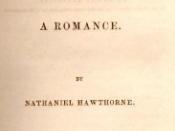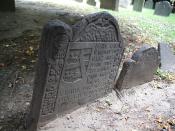SYMPATHY FOR A SINNER The portrayal of a main character, by the narrator, can make or break a novel. The glamour and Hollywood sparkle of diction can shine so bright in a reader's eyes that the narrator can make one forget all the wrong that has occurred in a novel. When a narrator is trying to send a reader down a certain emotional path he or she tries to create a distinct mood or feeling for the reader, usually this feeling is expressed by a certain tone. In the Scarlet Letter by Nathaniel Hawthorne, the narrator creates a sensitive tone throughout the Scaffold scene to allow the reader to sympathize and identify with Hester Prynne, the protagonist in the novel and under-dog in the battle against the cruel public, to redeem herself and her self-worth. Whether it is directly or indirectly, tone and diction are used throughout the Scaffold scene to create a sympathetic mood.
A narrator's description of a character can persuade the reader to like or dislike the character. For instance, "The bright morning sun, therefore, shone on broad shoulders and well-developed busts, and on round ruddy cheeks..."ÃÂ(page 53), the narrator specifically creates a tone where unflattering words are used to describe the countrywomen. The traits, like broad shoulders, give the reader a feeling that the women will be overwhelmingly aggressive. On the other hand, carefully chosen words describe Hester as the dainty, beautiful young woman with "perfect elegance on a large scale"ÃÂ(page 55). The reader will fancy Hester because of the pleasant tone and description of the young woman. When the countrywomen inflict words of pain towards Hester the reader receives a tone of jealousy from the countrywomen explaining why they want to punish Hester with a brand on her forehead. Astonished by the countrywomen's brutality, the reader identifies with and feels sorry for Hester because she can not help her natural beauty.
Although Hester has committed a crime, the punishment the narrator describes is so harshly illustrated that the reader sympathizes for Hester and immaculately forgets the whole reason for the punishment. Standing on the scaffold while broadcasting her shame with the letter "A"ÃÂ, the passionate sinner must face public humiliation. It is a daily reminder of the sin, adultery, which she has committed. One countrywoman allowed the reader to sympathize for the new mother when she said, "Not a stitch in that embroidered letter, but she has felt it in her heart."ÃÂ(Page 56). Hester also has a child who represents the scarlet letter that is embroidered near her heart and on her soul. To see the scarlet child and imagine what her future will be like reflects on Hester in the reader's heart, which then allows the feeling of sympathy to grow for the young sinner.
Unsurprisingly, the letter "A"ÃÂ brings anger among the countrywomen because of the way Hester presents it, "Why, gossips, what is it but to laugh in the faces of our godly magistrates, and make a pride out of what they, worthy gentlemen, meant for a punishment?"ÃÂ(Page 56). On the scaffold, Hester stands with an elaborately decorated letter in a fabric of scarlet, embroidered immaculately with a gold thread. She made this symbol of shame into a beautiful letter and almost seemed to wear it as a prideful piece of her attire. The act of making shame into pride shows a part of Hesters identity in the fact that she was not ashamed of the sin for she loved the man who brought this letter upon her. In the closing of the Scaffold scene, Hester shows her loyalty to this man who is becoming just as shameful and notorious as she is when she is asked to reveal his identity, "I will not speak!"ÃÂ(Page 71), her character, or identity, becomes known to the reader that she is a loyal person and will use all the love and passion she has for this man to suffer daily just to keep him safe from the harshness of persecution. The reader, while learning about her identity, again will sympathize for her pain in being persecuted.
In the thousands of descriptive words one can choose, if a narrator wants to persuade the reader's feelings to sympathize for a certain character, in this case, Hester, he or she will create a distinct mood or feeling for the reader expressed by a lucid tone. In the Scaffold scene of the Scarlet Letter, a persuasive, sympathetic tone is often expressed for the protagonist, Hester Prynne, for she is ridiculed profusely by the countrywomen, one of the many reasons why this novel will always remain a masterpiece. Hawthorne's narrator, on a win or die mission, sets a gracious tone and uses choice diction to persuade the reader to identify with the feelings, beliefs, and choices of a character; after conquering the readers emotions, it is he who wins the battle and makes the novel.





